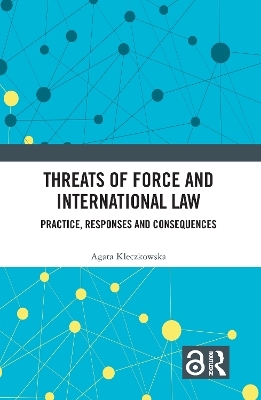
Threats of Force and International Law
Routledge (Verlag)
978-1-032-44627-1 (ISBN)
Threats of force are an inherent part of communication between some States. One prominent example is the 2017–2018 crisis in relations between the United States and North Korea, marked by multiple threats issued by both sides. Yet, despite the fact that States seem to use threats of force with unlimited freedom, they are prohibited by international law. This book presents threats of force from the perspective of the practice of States. Thus, the book is based on an examination of multiple cases when States reported threats of force. It describes what threats of force are, examines the status of the prohibition of threats of force as a legal norm, presents examples and describes the mechanisms that are available for States in case threats occur, as well as their legal consequences. The book will be an invaluable resource for academics and researchers in the areas of international security law, public international law, law of armed conflict and international relations.
The Open Access version of this book, available at http://www.taylorfrancis.com, has been made available under a Creative Commons Attribution (CC-BY) 4.0 license.
Agata Kleczkowska is Assistant Professor in the Department of Public International Law, Institute of Law Studies, Polish Academy of Sciences, Warsaw, Poland.
List of abbreviations
Introduction
1 History and definition of the threats of force
Introduction
1.1 The history of the prohibition of threats of force
1.2 Definition of the threat of force
1.2.1 Forms of threats of force
1.2.2 Subjective elements – intent to use force and credibility of threats
1.2.3 The objective of the threat of force
1.2.4 Other elements of the threat of force
1.2.5 Summary
2 The status of the prohibition of the threats of force
Introduction
2.1 The prohibition of the threats of force v. the prohibition of the use of force
2.1.1 ‘[A]gainst the territorial integrity and political independence or in any other manner inconsistent with the purposes of the United Nations’
2.1.2 Exceptions to the prohibition of the threats of force
2.2 Other norms breached by the threat of force
2.3 Different kinds of threats
2.4 Is the prohibition of threats of force a peremptory norm or a customary norm?
2.5 Conclusions
3 Threats of force in practice
Introduction
3.1 Threats of force as actions
3.1.1 Threats of force involving the movement of armed forces
3.1.1.1 Military manoeuvres
3.1.1.2 Concentration of forces
3.1.1.3 Mobilization of forces
3.1.2 Possession of nuclear weapons
3.1.3 Violation of airspace and territorial waters
3.2 Oral threats of force
3.3 Written threats of force
3.4 Ultimatums
3.5 Domestic legislation of states
3.6 War propaganda
3.7 ‘Accumulation of events’ as a threat of force
3.8 Conclusions
4 Responses to threats of force
Introduction
4.1 Responses to threats of force under the framework of international organizations
4.1.1 The United Nations
4.1.1.1 The UN Security Council
4.1.1.2 The UN General Assembly
4.1.1.3 Other UN organs
4.1.2 Organs outside the United Nations
4.1.3 Conclusions
4.2 Measures outside international organizations
4.3 Conclusions
5 Consequences of threats of force
Introduction
5.1 Consequences of threats of force when they were and were not followed by the use of force
5.1.1 Threats of force that were not followed by the use of force
5.1.2 Threats of force followed by the use of force
5.1.3 Conclusions
5.2 Ex injuria jus non oritur
5.2.1 Prohibition of illegal territorial acquisitions
5.2.2 Invalidity of treaties concluded as the result of illegal threats of force
5.3 Conclusions
Final conclusions
Index
| Erscheinungsdatum | 11.07.2023 |
|---|---|
| Verlagsort | London |
| Sprache | englisch |
| Maße | 156 x 234 mm |
| Gewicht | 430 g |
| Themenwelt | Recht / Steuern ► Allgemeines / Lexika |
| Recht / Steuern ► EU / Internationales Recht | |
| Sozialwissenschaften ► Politik / Verwaltung | |
| ISBN-10 | 1-032-44627-7 / 1032446277 |
| ISBN-13 | 978-1-032-44627-1 / 9781032446271 |
| Zustand | Neuware |
| Haben Sie eine Frage zum Produkt? |
aus dem Bereich


